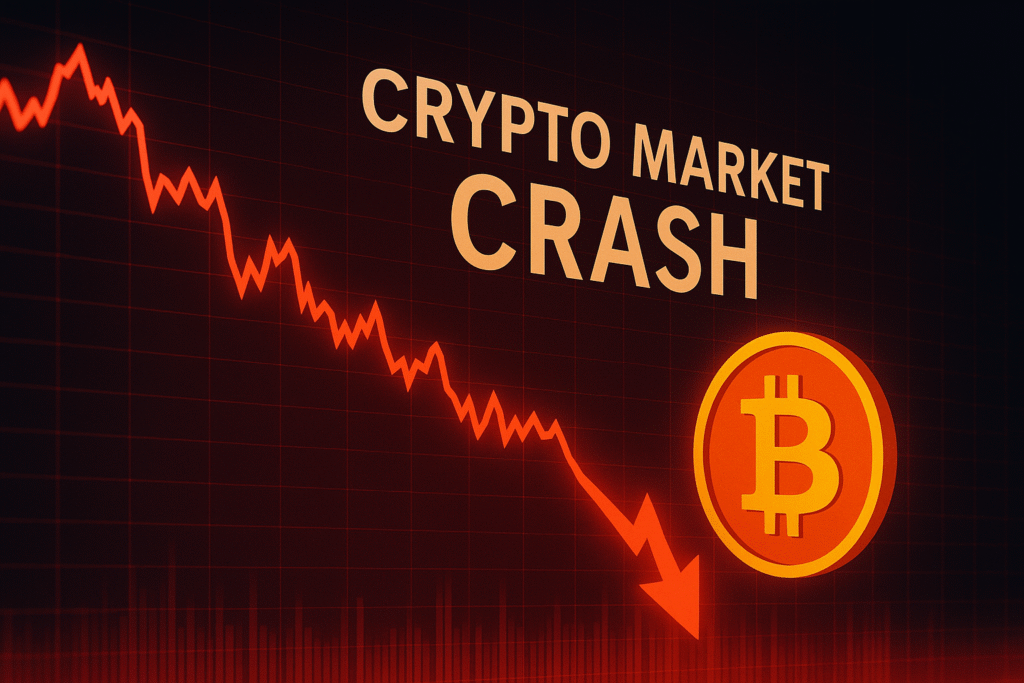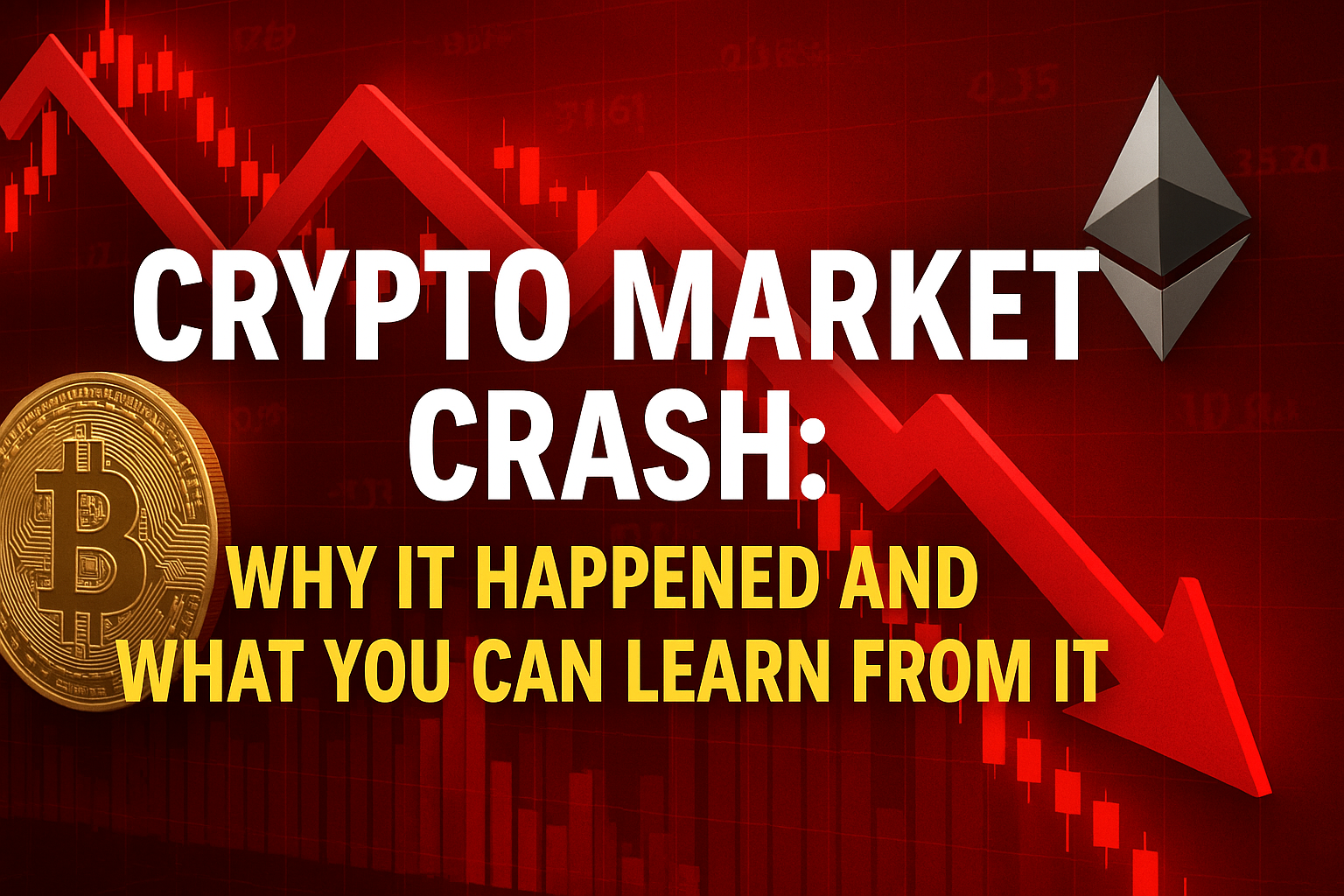Table of Contents
In early 2022, I watched in real-time as my crypto portfolio lost nearly 60% of its value within a few weeks. I remember staring at the red candlesticks, wondering if I had made a terrible mistake investing in digital assets. That event wasn’t just about me—it was part of a larger phenomenon that affected millions around the globe. This article isn’t about scaring you. It’s about understanding the crypto market crash, why it happens, what patterns we can identify, and how we can move forward more prepared.
The Nature of the Beast: What Is a Crypto Market Crash?
A crypto market crash refers to a rapid, often unexpected decline in the market value of cryptocurrencies. These crashes often wipe out billions—or even trillions—of dollars in market cap within hours or days. Unlike traditional financial markets that are bound by market hours and circuit breakers, the crypto market operates 24/7. That means panic can spread faster and deeper, especially when fear grips investors across time zones.
The crypto ecosystem is extremely volatile due to its speculative nature, lack of regulation, and the high influence of social media hype. In one crash alone, Bitcoin—the largest cryptocurrency—has seen up to 80% of its value slashed. Altcoins often drop even harder.
But a crash is more than numbers on a screen. It’s about lost confidence, broken dreams, and sometimes even financial ruin.
Real-World Case Study: The Terra-LUNA Collapse
One of the most infamous examples of a crypto market crash happened in May 2022 when the Terra ecosystem collapsed. TerraUSD (UST), a stablecoin, lost its peg to the US Dollar. In a matter of days, the price of LUNA dropped from over $80 to fractions of a cent.
The collapse was triggered by a massive sell-off, compounded by the fact that the UST-LUNA algorithm was designed in a way that couldn’t handle the volume of redemptions. This crash caused an estimated $60 billion loss in market capitalization.
Several retail investors lost their life savings. Others reported mental health issues from the stress. The ripple effect extended far beyond just Terra holders. It shook investor trust in stablecoins, which were considered relatively safe in the crypto space.
This single event acted like a domino and led to widespread panic, dragging down Bitcoin and Ethereum and intensifying the overall crypto market crash.
The Domino Effect: When One Coin Falls, They All Follow
Cryptocurrencies are heavily correlated. When Bitcoin sneezes, the rest of the market catches a cold. During every crypto market crash, you’ll notice a chain reaction:
- Bitcoin starts falling.
- Major altcoins like Ethereum, Solana, and Cardano follow suit.
- Meme coins and newer tokens get obliterated.
The 2021–2022 crash saw Bitcoin drop from an all-time high of nearly $69,000 to under $17,000 by the end of 2022. That’s more than 75% wiped out.
But what’s more important is understanding why this correlation happens. Part of it has to do with how institutional investors treat crypto. They often enter and exit the market based on macroeconomic indicators like interest rates and inflation expectations. When they pull out of Bitcoin, they tend to exit the entire space. This triggers a liquidity crisis and leads to further selling.
It’s not just about prices dropping—it’s about liquidity vanishing. Order books get thin. Slippage increases. Fear takes over.
Emotional Investing: A Human Problem in a Digital World
Here’s where I bring in a personal note. During the 2022 crypto market crash, I kept refreshing CoinMarketCap every 30 seconds. I knew logically that panic selling wasn’t the answer, but emotionally, I felt like everything I had worked for was vanishing.
That’s a common reaction. Crypto attracts young investors, many of whom are participating in a financial market for the first time. They come in during bull runs, expecting quick returns, and often don’t have the experience to manage risk.
Add social media FOMO to that, and you have a recipe for disaster. Influencers telling followers to “buy the dip” or “HODL” can sometimes worsen the outcome. I’ve seen people mortgage their homes to buy crypto at peak prices, only to face devastating losses weeks later.
The psychology of fear, greed, and herd behavior plays a massive role in every crypto market crash.
External Triggers: The Macro Picture
Crypto doesn’t operate in a vacuum. In fact, many crypto market crashes are tied to global financial events.
Let’s take the 2022 crash again as an example. Rising interest rates by the Federal Reserve made risky assets less attractive. Stock markets dipped. Tech companies saw massive layoffs. That environment was toxic for speculative assets like crypto.
Then there were geopolitical tensions—like the war in Ukraine—and supply chain disruptions that increased uncertainty. When people are unsure about the future, they tend to withdraw money from volatile markets.
These macroeconomic factors created an environment where confidence in crypto dropped sharply. Retail investors started selling. Exchanges began facing liquidity issues. Some like Celsius and Voyager even froze withdrawals, worsening the panic.
Regulatory Uncertainty: A Silent Killer of Confidence
Another key driver in many crypto market crash events is regulatory pressure. Whether it’s a sudden announcement of a ban, a lawsuit from the SEC, or even rumors of crackdowns in regions like China or India—regulatory fears always create instability.
In June 2021, China banned crypto mining and declared all crypto transactions illegal. That caused Bitcoin’s hash rate to plummet and led to a sharp market drop. Exchanges operating in uncertain legal environments were forced to shut down or leave the region, further adding to the chaos.
Even today, regulatory clarity remains a major challenge. The lack of clear rules makes both institutional and retail investors nervous. Every time a government tightens its stance, it raises fears of another crypto market crash.

Exchange Failures: When Platforms Collapse Alongside Coins
In the decentralized world of crypto, centralized exchanges still play a massive role in trading activity. But ironically, they often become the weak link during a crypto market crash.
A vivid case was the collapse of FTX in November 2022. At its peak, FTX was the second-largest exchange in the world, managing billions in daily volume. But a leaked balance sheet revealed that much of its reserves were held in illiquid assets—mainly FTT tokens that it had created itself.
Once the news spread, panic withdrawals began. Within days, FTX went from a leading crypto giant to filing for bankruptcy. Over a million users lost access to their funds. This shook global investor confidence, and prices plummeted across the board.
The crypto market crash triggered by FTX was different from earlier crashes. It wasn’t just about price correction—it was about trust erosion. Users began questioning whether any centralized exchange was safe. Withdrawals from other exchanges like Binance spiked. The contagion was psychological.
As an investor myself, I remember pulling out most of my assets to cold wallets during that week. And I wasn’t alone—cold wallet usage hit record highs. People were no longer betting against crypto—they were betting against platforms.
The Role of Leverage: Fuel on the Fire
A less visible—but incredibly destructive—element of any crypto market crash is leverage.
Many crypto exchanges offer 10x, 50x, or even 100x leverage on trades. While this can amplify profits, it also magnifies losses dramatically. In bull markets, it’s common for new traders to borrow heavily to ride the trend. But in a crash, these leveraged positions get liquidated in minutes.
For example, during the May 2021 flash crash, over $8 billion in leveraged positions were liquidated in a single day. That’s more than a collapse—it’s a liquidation tsunami.
What makes this worse is the automated nature of the process. Once liquidation thresholds are breached, bots sell the assets without emotion. This creates cascading sell-offs that deepen the crash.
It’s one of the hardest lessons for traders: leverage isn’t free power—it’s borrowed confidence. And in every crypto market crash, that confidence gets tested brutally.
The Impact on Institutions and Venture Capital
Another dimension to the crypto market crash is how it affects institutional investments and VC-backed startups.
During the 2021 bull run, hundreds of crypto projects received VC funding. They promised the world: DeFi protocols, metaverse integrations, AI-crypto hybrids—you name it. But as the crash unfolded, many of these projects struggled to survive.
Investors pulled out. Token values dropped below seed-round prices. Several projects like Celsius, BlockFi, and even Three Arrows Capital collapsed due to insolvency.
When institutional players go down, they don’t go quietly. Their collapse takes down lenders, borrowers, employees, and thousands of retail participants. It’s a domino effect that changes the landscape permanently.
For startups, the crash meant layoffs, paused development, and missed roadmaps. As someone who was advising a crypto startup during the time, I saw morale drop like a stone. Talented developers left the space entirely. The culture shifted from “build to moon” to “survive at all costs.”
Media Influence: The Amplifier of Panic
Media—especially crypto-specific news outlets—play a unique role during a crypto market crash. When the price drops, headlines become more dramatic. Phrases like “Bitcoin is dead”, “Crypto Armageddon”, and “Digital gold turns to dust” become common.
Social media worsens it. Twitter, Reddit, and YouTube flood with predictions, panic, and misinformation. Even a single tweet from a prominent figure can tank the market. Elon Musk’s tweet in 2021 about Bitcoin’s environmental impact led to a $300 billion loss in market cap within days.
The algorithm favors engagement—and fear sells more than facts. Unfortunately, this leads to herd behavior. Retail investors who consume this fear often sell at the bottom, locking in losses.
I’ve learned the hard way: during a crypto market crash, the worst thing you can do is base your decisions purely on headlines. Market decisions should be data-driven, not dopamine-driven.
Learning From the Fall: How to Prepare for the Next Crash
Every crash is a teacher. The problem is, most people ignore the lessons once the bull market returns.
Here’s what I’ve personally adopted since the last major crypto market crash:
- Diversification: I no longer keep all assets in high-risk tokens. I balance blue-chip cryptos, stablecoins, and even some in traditional markets.
- Cold Storage: Exchanges can fail. Hardware wallets don’t.
- Leverage Discipline: I use no more than 3x leverage—and never without a stop-loss.
- Cash Reserve: Crashes create buying opportunities. I always keep dry powder ready.
But more than anything, I’ve changed my mindset. Crypto is a long-term game. The tech is revolutionary—but the market is unforgiving. FOMO and YOLO are fun until they ruin your savings.
The Silver Lining: What Good Comes Out of a Crypto Crash?
Believe it or not, crypto market crashes aren’t entirely bad. They clear out scams, poorly managed projects, and unsustainable business models. In the 2018 crash, 80% of ICOs failed. But that clean-up led to better standards and stronger projects.
The post-2022 crash led to serious discussions on regulation, risk management, and transparency. Many platforms introduced proof-of-reserve systems. Cold wallet usage became mainstream. Retail education improved.
These are growing pains. Just like the dot-com bubble paved the way for Amazon and Google, today’s crash may be clearing the path for tomorrow’s Web3 giants.
Crashes Are Part of the Game
If you’ve experienced a crypto market crash, you know the emotional toll it takes. But with every crash, there’s a lesson. A chance to reassess, rebalance, and re-enter smarter.
Crypto is still in its early stages. Volatility is the price of innovation. The key is to survive long enough to benefit from the next cycle.
As I write this, Bitcoin is slowly climbing again. Some altcoins are recovering. New projects are being built quietly in the background. And yet, the fear from the last crash still lingers.
And maybe that’s a good thing—it reminds us that risk is real, hype is temporary, and discipline matters more than ever.
My Biggest Mistake (And Lesson)
Looking back, my biggest mistake during the last crypto market crash wasn’t buying high or even trusting an exchange—it was not having a clear plan.
I had entered the market during a bull run. I bought tokens because influencers were hyping them. I told myself I was investing, but in reality, I was just gambling with emotions. When the crash came, I panicked, sold at a loss, and then watched prices recover later. That experience taught me one of the most powerful lessons in investing: your strategy should be stronger than your feelings.
Now, I approach crypto like a business. I write down my entries, exits, and rationale. I backtest before I trade. And I never put in money I can’t afford to lose.
The next time a crypto market crash comes—and it will—I’ll be ready. And hopefully, so will you.
Frequently Asked Questions (FAQs)
Q1: What causes a crypto market crash?
Several factors can cause a crypto market crash, including:
- Regulatory crackdowns (e.g., China banning mining)
- Exchange failures (like FTX)
- Stablecoin depegging (like TerraUSD)
- Global economic uncertainty
- Social media-induced panic
- Over-leveraged positions getting liquidated
Usually, it’s a combination of these triggers that leads to a widespread sell-off.
Q2: How long does a crypto crash last?
There’s no fixed duration. Some crashes are short-term corrections lasting a few days or weeks. Others, like the 2018–2019 bear market, stretched over a year.
Recovery depends on:
- The severity of the crash
- Investor sentiment
- Regulatory developments
- Technological innovations
The key is not to time the bottom but to invest with a long-term view.
Q3: Can you profit during a crash?
Yes, but it requires preparation and discipline. Some strategies include:
- Buying blue-chip assets at discounted prices
- Dollar-cost averaging (DCA)
- Shorting using derivatives (for advanced traders)
- Yield farming or staking stablecoins to earn passive income
However, these strategies involve risk and should only be executed with clear risk management.
Q4: Are stablecoins safe during a crash?
Not always. While fiat-backed stablecoins like USDC or USDT are generally safer, algorithmic stablecoins (like UST) have failed in the past. During a crypto market crash, even stablecoins can lose their peg if there’s extreme panic.
Always choose reputable, audited stablecoins and avoid keeping large sums on risky protocols.
Q5: Should I sell during a crypto crash?
That depends on your strategy. If you’re a long-term investor with conviction in the asset, selling at a low may lock in losses. If you’re a short-term trader or using borrowed funds, cutting losses may make sense.
The golden rule is: never sell purely out of panic. Make decisions based on analysis, not emotion.
Q6: How do I protect my crypto portfolio from crashes?
Some risk management tips include:
- Diversifying across assets
- Avoiding excessive leverage
- Using cold wallets
- Taking partial profits during bull runs
- Having an emergency cash reserve
- Setting stop-loss and take-profit levels
Preparation is your best shield during a crypto market crash.
Q7: Will crypto ever recover after a crash?
Historically, yes. Every crypto market crash has been followed by a recovery. Bitcoin crashed in 2013, 2018, and 2022—but came back stronger each time.
However, not all projects survive. That’s why it’s crucial to invest in assets with strong fundamentals and active development teams.
The Market Doesn’t Crash, Expectations Do
It’s tempting to blame the market, the media, or even whales for a crypto market crash. But in many cases, it’s our own unchecked expectations that get shattered.
We expect prices to only go up. We expect hype to last forever. We expect crypto to be a shortcut to wealth.
But the truth? Crypto is a marathon, not a lottery.
Crashes are part of the journey—not the end of it.
If you’ve survived a crypto market crash, you already know more than half of new investors. If you’ve learned from it, you’re ahead of most.
So, take that knowledge. Build your strategy. And when the next cycle comes—ride it with wisdom, not wishful thinking.




Leave a Reply